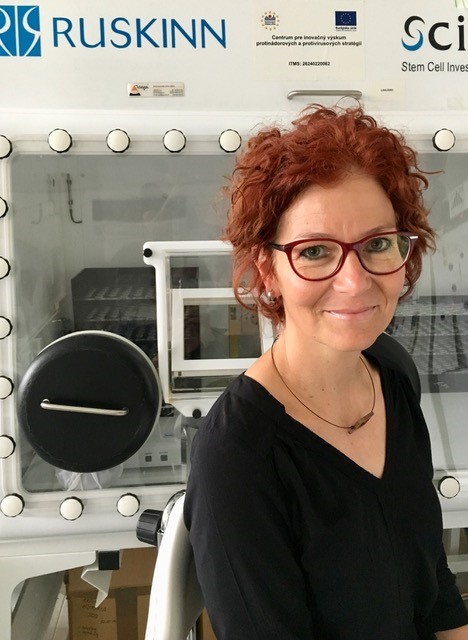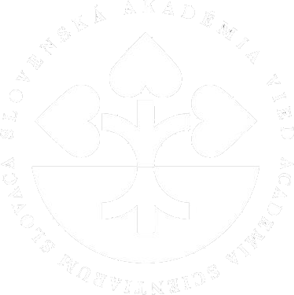Department of Cancer Biology
Research Topic
Physiological factors in tumor microenvironment, namely hypoxia and acidosis, considerably contribute to cancer progression. Hypoxia results from insufficient oxygenation of tumor cells through aberrant and non-functional blood vessels and leads to acquisition of aggressive tumor phenotype, including resistance to chemotherapy and radiotherapy as well as to increased invasiveness and metastatic propensity.
Hypoxia also supports oncogenic metabolism generating excess of acidic products, such as lactate ions, protons and carbon dioxide, which are eliminated from cells through ion transporters/exchangers or by intracellular neutralization with bicarbonate ions. This allows for neutralization/alkalinisation of intracellular pH and acidification of extracellular pH. Acidosis has similar phenotypic effects as hypoxia and therefore, detection of both hypoxia and acidosis in tumors is clinically relevant.
We investigate tumor hypoxia and acidosis in order to better elucidate molecular mechanisms of cancer cell adaptation to these stresses in tumor microenvironment with particular focus on carbonic anhydrase IX (CA IX) that was identified and cloned in our institution, and our team has considerably contributed to its molecular and functional characterization and to production of specific monoclonal antibodies and other reagents for CA IX research and clinical applications.
CA IX is induced by hypoxia and plays a role in tumor acidosis. It is primarily localized on the cell surface, where it controls pH and supports survival and invasiveness of tumor cells. It can be also released to body fluids via mechanism of ectodomain shedding. Expression of CA IX is strongly associated with cancer and is currently used worldwide as a biomarker of hypoxia and acidosis in diverse tumor types with potential prognostic and/or predictive value. CA IX is also under clinical development as promising therapeutic target.
Our recent research interests include the role of CA IX in tumor metabolism, in metastatic cascade and in signalling pathways supporting cancer progression. We also investigate effects of drugs and inhibitors on expression levels and activity of CA IX. Our major goal is to open new avenues of CA IX use in diagnostics and therapy.
Research Team

PRINCIPAL INVESTIGATORS:
prof. RNDr. Silvia Pastoreková, DrSc.
MVDr. Juraj Kopáček, DrSc.
EMERITUS:
prof. RNDr. Jaromír Pastorek, DrSc. (professor Emeritus) – co-founder of cancer-associated protein CA IX; long-term member of the team and head of Department of cancer biology (1992 – 1998), former director of Institute of Virology of SAS (2001 – 2009) and President of Slovak Academy of Sciences (2009 – 2014)
RESEARCHERS:
RNDr. Monika Baráthová, PhD., Deputy Head of Department, group leader
RNDr. Petra Belvončíková, PhD.
RNDr. Lucia Csáderová, PhD.
PharmDr. Tereza Goliaš, PhD.
RNDr. Katarína Grossmannová, PhD.
Mgr. Ivana Kajanová, PhD.
RNDr. Martina Labudová, PhD.
RNDr. Ingeborg Režuchová, PhD.
RNDr. Martina Takáčová, PhD.
RNDr. Miriam Zaťovičová, CSc., group leader
SCIENTIFIC STAFF:
RNDr. Mária Bartošová, PhD.
Mgr. Eva Kocianová, PhD.
RNDr. Mariia Lohoida, PhD.
RNDr. Ľubomíra Lukáčiková, PhD.
Ing. Barbora Puzderová, PhD.
Mgr. Lucia Škvarková, PhD.
SCIENTIFIC AND TECHNICAL STAFF:
Mgr. Lenka Jelenská
PhD. STUDENTS:
Mgr. Kamila Bernátová
Mgr. Jana Lapinová
Mgr. Viktória Piatriková
Mgr. Katarína Ščasná
Mgr. Tomáš Talač
External PhD. Students:
MUDr. Silvia Fečíková, št. odbor Onkológia, LF UK, ext. pracovisko NÚTPCH a HCH Vyšné Hágy
LABORATORY:
Jana Išová
Alena Kosorínová
Projects of SRDA (Slovak Research and Development Agency)
Cytokine profiling together with carbonic anhydrase IX immunotargeting as a promising tool in diagnostics and treatment of pancreatic cancer. Project code: APVV-20-0480, PI: Eliška Švastová. Duration: 07/2021-06/2025.
Nanomedical approach to fight pancreatic cancer via targeting tumor-associated carbonic anhydrase IX. Project code: APVV-20-0485, PI: Lucia Csaderova. Duration: 07/2021-06/2025.
Development of unique TiMg composite dental implant. Project code: APVV-20-0417. Collaborative project. PI in BMC: Martina Takacova. Duration: 07/2021-06/2025.
Elucidation of novel pro-metastatic functions of tumor-associated carbonic anhydrase IX and its cross-talk with proinflammatory response. Project code: APVV 14-0816. PI: Eliška Švastová. Duration: 2015-2019.
The role of CA IX in adaptation to tumor microenvironment and in resistance to anticancer therapy: molecular mechanisms and clinical implications. Project code: APVV 15-0697. PI: Silvia Pastoreková. Duration: 2016-2020.
Activity Assay of Transfer Factor, Immunostimulatory Drug from Leukocytes Extract And Its Preparation Standardization. Project code: APVV 15-0720, PI: Juraj Kopáček. Duration: 2016-2020.
Impact of comorbidity therapy on tumorigenesis and a role of the tumor microenvironment in this process. Project code: APVV 16-0343, PI: Monika Baráthová. Duration: 2017-2021.
Cell-in-cell phenomena as microevolutionary processes in cancer progression: a role for hypoxia-induced carbonic anhydrase IX. Project code: APVV 19-0098, PI: Silvia Pastoreková, Duration: 2020-2024.
Projects of VEGA (Scientific Grant Agency of the Ministry of Education, of the SR and the Slovak Academy of Sciences)
Effects of natural polyphenol and nonsteroidal anti-inflammatory drug combination therapy on the tumormicroe nvironment. Project code: VEGA (2/0061/21), PI: Katarína Grossmannová. Duration: 2021-2024.
Regulation of pyruvate dehydrogenase kinase 1 activity in the control of glycolytic metabolism in hypoxic tumors. Project code: VEGA (2/0078/19), PI: Tereza Goliaš. Duration: 2019-2022.
Study of pro-metastatic functions of carbonic anhydrase IX, relationship between CA IX and mucins and hypoxic microenvironment in pancreatic cancer. Project code: VEGA (2/0105/19), PI: Eliška Švastová. Duration: 2019-2022.
Unraveling the mechanisms linking obesity and cancer progression: the interplay between adipocytes and cancer cells. Project code: VEGA (2/0076/20), PI: Martina Takáčová. Duration: 2020-2023.
Effect of combination therapy with carnosine on tumorigenesis in colorectal carcinoma models. Project code: VEGA (VEGA 2/0090/20), PI: Monika Baráthová. Duration: 2020-2023.
Carbonic anhydrase IX as one of the key components of exosomes secreted from cancer cells. Project code: VEGA (2/0074/20), PI: Miriam Zaťovičová. Duration: 2020-2023.
Collaboration projects:
Projects of The Ministry of Education, Science, Research and Sport of the Slovak Republic:
Research of humanized antibodies in targeted treatment of hypoxic tumors. Project code: (2018/14554:1-26C0), principal investigator: MABPRO a.s., PI: Jaromír Pastorek; Cooperating organization: BMC SAV, PI: Silvia Pastoreková. Duration: 2018-2021.
Projects of The Ministry of Health of the Slovak Republic:
Clinical evaluation of prognostic and predictive value of tissue and serum Carbonic Anhydrase IX in breast cancer. Project code: MZ SR 2019/26-LFUK-14. PI: Faculty of Medicine, Comenius University, Bratislava. PI: Kamil Pohlodek; Cooperating organization: BMC SAV, PI: Ingeborg Režuchová. Duration: 2019/2021.
European Union Structural Funds projects:
Integrative strategy in development of personalized medicine of selected malignant tumours and its impact on quality of life (LISPER). Project code: 313011V446, PI: Lekárska fakulta, UK BA, PI: Lukáš Plank; Cooperating organization: BMC SAV, PI: Miroslav Chovanec. Duration: 2019-2021.
Long-term strategic research of prevention, intervention and mechanisms of obesity and its comorbidities. Project code: NFP313010V344, PI: BMC SAV, PI: Silvia Pastoreková. Duration: 2020-2023.
Selected previous projects:
Biochips and biosensors for glycorecognition, their development, preparation and application in cancer research. Project code: APVV-14-0753. Coordinator: Institute of Chemistry, PI: Jaroslav Katrlík. Partner organization: Biomedical Research Center SAS, PI: Eliška Švastova. Duration: 2015-2019.
Role of the CA IX ectodomain in tumor growth and metastasis. Project code: Leona Lauder and George Schwab Foundation. PI: Silvia Pastoreková. Duration: 2014-2019.
Elucidation of novel pro-metastatic functions of hypoxia-induced carbonic anhydrase IX in pancreatic cancer. Slovak Academic Information Agency (SAIA)—Action Austria—Slovakia. Coordinator: BRC SAS, PI: Eliška Švastova. Host institution: Medical University of Vienna, Institute of Cancer Research, Supervisor: Paola Martinelli. Duration: 02/2018 – 07/2018.
Targeting carbonic anhydrase IX and pyruvate dehydrogenase kinase 1 in hypoxic colorectal tumors. Project code: SASPRO-0035/01/02, PI: Tereza Goliaš. Duration: 2015-2018.
Association of the hypoxia-induced carbonic anhydrase IX with drug response, miRNA profile and oncogenic pathways: from integrative analysis of the NCI60 cancer cell panel to cancer patients. Project code: SAS-MOST-JRP 2014/10. PI: Silvia Pastoreková. Duration: 2015-2017.
Biomedical engineering for cancer and brain disease diagnosis and therapy development. Project code: FP7-PEOPLE-2010-ITN-264417 (Project of the 7th Framework Program of the EU). Coordinator: Michiel J Vellekoop, Vienna University of Technology; Partner Organization: Institute of Virology, SAS, PI: Silvia Pastoreková. Duration: 2011-2015.
Metastatic tumour facilitated by hypoxic tumour microenvironments (METOXIA). Project code: HEALTH-2007-222741 (Project of the 7th Framework Program of the EU). Coordinator: Erik O. Pettersen, University of Oslo; Partner Organization: Institute of Virology, SAS, PI: Silvia Pastoreková. Duration: 2009-2014.
Hypoxia sensing, signalling and adaptation. Project code: COST Action TD0901. Coordinator: Roland Wenger, University of Zurich; Partner organization: Institute of Virology, SAS, PI: Silvia Pastoreková. Duration: 2009-2013.
RECENT
2022
Zatovicova M, Kajanova I, Barathova M, Takacova M, Labudova M, Csaderova L, Jelenska L, Svastova E, Pastorekova S, Harris AL, Pastorek J. Novel humanized monoclonal antibodies for targeting hypoxic human tumors via two distinct extracellular domains of carbonic anhydrase IX. Cancer Metab. 2022 Feb 2;10(1):3. doi: 10.1186/s40170-022-00279-8.PMID: 35109923
Takacova M, Kajanova I, Kolarcikova M, Lapinova J, Zatovicova M, Pastorekova S. Understanding metabolic alterations and heterogeneity in cancer progression through validated immunodetection of key molecular components: a case of carbonic anhydrase IX. Cancer Metastasis Rev. Jan 2022 Dec;40(4):1035-1053. doi: 10.1007/s10555-021-10011-5. Epub 2022 Jan 26.PMID: 35080763
Grossmannova K, Barathova M, Belvoncikova P, Lauko V, Csaderova L, Tomka J, Dulka T, Pastorek J, Madaric J. Hypoxia Marker Carbonic Anhydrase IX Is Present in Abdominal Aortic Aneurysm Tissue and Plasma. Int J Mol Sci. 2022 Jan 14;23(2):879. doi: 10.3390/ijms23020879.PMID: 35055064
Urbanova M, Buocikova V, Trnkova L, Strapcova S, Kajabova VH, Melian EB, Novisedlakova M, Tomas M, Dubovan P, Earl J, Bizik J, Svastova E, Ciernikova S, Smolkova B. DNA Methylation Mediates EMT Gene Expression in Human Pancreatic Ductal Adenocarcinoma Cell Lines. Int J Mol Sci. 2022 Feb 14;23(4):2117. doi: 10.3390/ijms23042117.PMID: 35216235
2021
Ibrahim AMH, Takacova M, Jelenska L, Csaderova L, Balog M, Kopacek J, Svastova E, Krizik P. The effect of surface modification of TiMg composite on the in-vitro degradation response, cell survival, adhesion, and proliferation. Mater Sci Eng C Mater Biol Appl. 2021 Aug;127:112259. doi: 10.1016/j.msec.2021.112259. Epub 2021 Jun 17.PMID: 34225844
Antal I, Koneracka M, Kubovcikova M, Zavisova V, Jurikova A, Khmara I, Omastova M, Micusik M, Barathova M, Jelenska L, Kajanova I, Zatovicova M, Pastorekova S. Targeting of carbonic anhydrase IX-positive cancer cells by glycine Epub -coated superparamagnetic nanoparticles. Colloids Surf B Biointerfaces. 2021 Sep;205:111893. doi: 10.1016/j.colsurfb.2021.111893. 2021 Jun 2.PMID: 34116397
In cooperation:
Demandt JAF, Dubois LJ, van Kuijk K, Zaťovičová M, Jin H, Parkkila S, van der Laan SW, Jelenska L, Mees BME, Reutelingsperger CPM, Cleutjens KBJM, van der Kallen CJH, Schalkwijk CG, van Greevenbroek MMJ, Biessen EAL, Pasterkamp G, Pastoreková S, Stehouwer CDA, Sluimer JC. The hypoxia-sensor carbonic anhydrase IX affects macrophage metabolism, but is not a suitable biomarker for human cardiovascular disease. Sci Rep. 2021 Jan 11;11(1):425. doi: 10.1038/s41598-020-79978-5.PMID: 33432108
Echeverri Ruiz NP, Mohan V, Wu J, Scott S, Kreamer M, Benej M, Golias T, Papandreou I, Denko NC. Dynamic regulation of mitochondrial pyruvate metabolism is necessary for orthotopic pancreatic tumor growth. Cancer Metab. 2021 Nov 8;9(1):39. doi: 10.1186/s40170-021-00275-4.PMID: 34749809
2020
- Clinical and pre-clinical evidence of carbonic anhydrase ix in pancreatic cancer and its high expression in pre-cancerous lesions (2020). Cancers
- Impairment of hypoxia‐induced ca ix by beta‐ blocker propranolol—impact on progression and metastatic potential of colorectal cancer cells (2020). Int J Mol Sci.
- PIMT binding to c-terminal Ala459 of CAIX is involved in inside-out signaling necessary for its catalytic activity (2020). Int J Mol Sci.
- CAIX-mediated control of LIN28/let-7 axis contributes to metabolic adaptation of breast cancer cells to hypoxia (2020). International Journal of Molecular Sciences
- CA IX Stabilizes Intracellular pH to Maintain Metabolic Reprogramming and Proliferation in Hypoxia (2020). Frontiers in Oncology
- Impairment of carbonic anhydrase IX ectodomain cleavage reinforces tumorigenic and metastatic phenotype of cancer cells (2020). British Journal of Cancer
2019
- The role of carbonic anhydrase IX in cancer development: links to hypoxia, acidosis, and beyond. Cancer metastasis reviews
- Microenvironmental control of glucose metabolism in tumors by regulation of pyruvate dehydrogenase. International Journal of Cancer
- CAIX Regulates Invadopodia Formation through Both a pH-Dependent Mechanism and Interplay with Actin Regulatory Proteins. International journal of molecular sciences
- Carbonic Anhydrase IX-Mouse versus Human. International journal of molecular sciences
2017
- Lactate stimulates CA IX expression in normoxic cancer cells. Oncotarget
- Hypoxia induces cancer-associated cAMP/PKA signalling through HIF-mediated transcriptional control of adenylyl cyclases VI and VII. Scientific Reports
2016
- Cancer-associated S100P protein binds and inactivates p53, permits therapy-induced senescence and supports chemoresistance. Oncotarget
- Dexamethasone downregulates expression of carbonic anhydrase IX via HIF-1α and NF-κB-dependent mechanisms. International journal of oncology
- Apoptosis-induced ectodomain shedding of hypoxia-regulated carbonic anhydrase IX from tumor cells: a double-edged response to chemotherapy. BMC cancer
- Hypoxia increases the heterogeneity of melanoma cell populations and affects the response to vemurafenib. Molecular medicine reports
- Encapsulation of anti-carbonic anhydrase IX antibody in hydrogel microspheres for tumor targeting. Journal of enzyme inhibition and medicinal chemistry
- Perspective role of carnosine in tumor-related phenomena. Carnosine: Physiological Effects and Research Insights. ISBN: 978-1-53610-136-2
2015
- Hypoxia-induced carbonic anhydrase IX as a target for cancer therapy: from biology to clinical use. Seminars in cancer biology
MOST CITED
- Hypoxia activates the capacity of tumor-associated carbonic anhydrase IX to acidify extracellular pH. FEBS Letters
- Carbonic anhydrases: Current state of the art, therapeutic applications and future prospects. Journal of Enzyme Inhibition and Medicinal Chemistry
- Cloning and characterization of MN, a human tumor-associated protein with a domain homologous to carbonic anhydrase and a putative helix-loop-helix DNA binding segment. Oncogene. PMID: 8084592
- Human MN/CA9 gene, a novel member of the carbonic anhydrase family: Structure and exon to protein domain relationships (1996) Genomics
- Carbonic anhydrase IX, MN/CA IX: Analysis of stomach complementary DNA sequence and expression in human and rat alimentary tracts. Gastroenterology
- A novel quasi-viral agent, MaTu, is a two-component system. Virology
- Carbonic anhydrase IX reduces E-cadherin-mediated adhesion of MDCK cells via interaction with β-catenin. Experimental Cell Research
- Lowered oxygen tension induces expression of the hypoxia marker MN/carbonic anhydrase IX in the absence of hypoxia-inducible factor 1α stabilization: A role for phosphatidylinositol 3′-kinase. Cancer Research. PMID: 12154057
- Carbonic anhydrase IX interacts with bicarbonate transporters in lamellipodia and increases cell migration via its catalytic domain. Journal of Biological Chemistry
- Carbonic anhydrase IX, a hypoxia-induced catalytic component of the pH regulating machinery in tumors. Frontiers in Physiology
- Induction by hypoxia combined with low glucose or low bicarbonate and high posttranslational stability upon reoxygenation contribute to carbonic anhydrase IX expression in cancer cells. International journal of oncology. PMID: 15010840
- Phosphorylation of carbonic anhydrase IX controls its ability to mediate extracellular acidification in hypoxic tumors. Cancer Research
- Carbonic anhydrase IX as an anticancer therapy target: Preclinical evaluation of internalizing monoclonal antibodydirected to catalytic domain. Current Pharmaceutical Design
- Biodistribution and pharmacokinetics of 125I-labeled monoclonal antibody M75 specific for carbonic anhydrase IX, an intrinsic marker of hypoxia, in nude mice xenografted with human colorectal carcinoma. International Journal of Cancer
- Extracellular acidosis elevates carbonic anhydrase IX in human glioblastoma cells via transcriptional modulation that does not depend on hypoxia. International Journal of Oncology
- Ectodomain shedding of the hypoxia-induced carbonic anhydrase IX is a metalloprotease-dependent process regulated by TACE/ADAM17. British Journal of Cancer
- Monoclonal antibodies generated in carbonic anhydrase IX-deficient mice recognize different domains of tumourassociated hypoxia-induced carbonic anhydrase IX. Journal of Immunological Methods
- Alternative splicing variant of the hypoxia marker carbonic anhydrase IX expressed independently of hypoxia and tumour phenotype. British Journal of Cancer
- MAPK pathway contributes to density- and hypoxia-induced expression of the tumor-associated carbonic anhydrase IX. Biochimica et Biophysica Acta – Gene Structure and Expression
- The effect of carbonic anhydrase IX on focal contacts during cell spreading and migration. Frontiers in Physiology
- Carbonic anhydrase IX is a clinically significant tissue and serum biomarker associated with renal cell carcinoma. Oncology Letters
COLLABORATIVE PAPERS:
- Hypoxia-inducible expression of tumor associated carbonic anhydrases. Cancer Research. PMID: 11156414
- Carbonic anhydrase (CA IX) expression, a potential new intrinsic marker of hypoxia: Correlations with tumor oxygen measurements and prognosis in locally advanced carcinoma of the cervix. Cancer Research. PMID: 11522632
- Prognostic significance of a novel hypoxia-regulated marker, carbonic anhydrase IX, in invasive breast carcinoma. Journal of Clinical Oncology
- Crystal structure of the catalytic domain of the tumor-associated human carbonic anhydrase IX. Proceedings of the National Academy of Sciences of the United States of America
- Expression of hypoxia-inducible carbonic anhydrase-9 relates to angiogenic pathways and independently to poor outcome in non-small cell lung cancer. Cancer Research. PMID: 11691824
- Hypoxia-regulated carbonic anhydrase-9 (CA9) relates to poor vascularization and resistance of squamous cell head and neck cancer to chemoradiotherapy. Clinical Cancer Research. PMID: 11705854
- Biochemical characterization of CA IX, one of the most active carbonic anhydrase isozymes. Journal of Biological Chemistry
- Carbonic anhydrase inhibitors: The first selective, membrane-impermeant inhibitors targeting the tumor-associated isozyme IX. Bioorganic and Medicinal Chemistry Letters
- Imaging the hypoxia surrogate marker CA IX requires expression and catalytic activity for binding fluorescent sulfonamide inhibitors. Radiotherapy and Oncology
- Expression of carbonic anhydrase IX in astrocytic tumors predicts poor prognosis. Clinical Cancer Research
- Interactions of transmembrane carbonic anhydrase, CAIX, with bicarbonate transporters. American Journal of Physiology – Cell Physiology
- Gastric hyperplasia in mice with targeted disruption of the carbonic anhydrase gene Car9. Gastroenterology
- Expression of transmembrane carbonic anhydrases IX and XII in ovarian tumours. Histopathology
- The proteoglycan region of the tumor-associated carbonic anhydrase isoform IX acts as anintrinsic buffer optimizing CO2 hydration at acidic pH values characteristic of solid tumors. Bioorganic and Medicinal Chemistry Letters
PATENTS
MN Gene and Protein, US patent 5,384,676 (inventori Závada, Pastoreková, Pastorek) a ďalšie rodiny medzinárodných patentov zameraných na diagnostické a terapeutické využitie nádorovo-asociovaného proteínu CA IX (pôvodne nazvaného MN),
Vrátane:
MN/CA9 splice variants (Pastorek, Baráthová)
MN/CA IX-specific monoclonal antibodies generated from MN/CA IX-deficient mice and methods of use (Pastorek, Pastoreková, Zaťovičová, Závada, Ortová-Gut, Závadová)
Soluble Form of Carbonic Anhydrase IX (s-CA IX), Assays to Detect s-CA IX, CA IXs Coexpression with HER-2/neu/c-erbB-2 and CA IX-Specific Monoclonal Antibodies to Non-Immunodominant Epitopes (Pastorek, Pastoreková, Zaťovičová, Závada, Ortová-Gut, Závadová)







